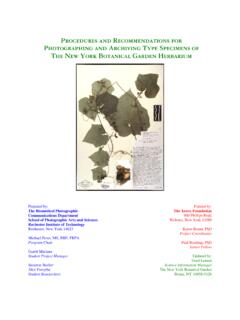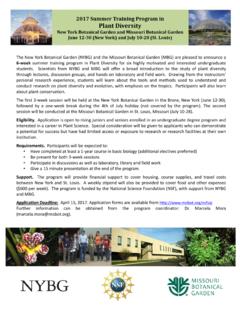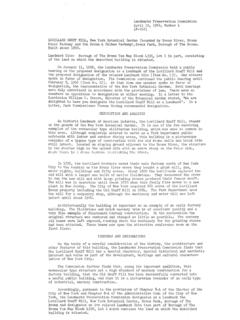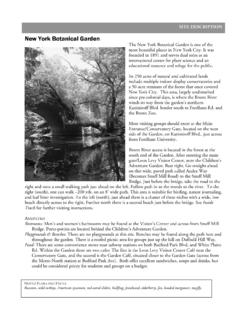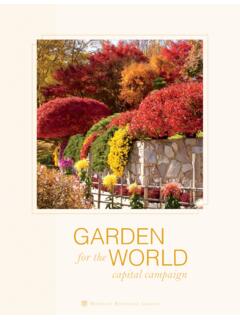Transcription of THE BOTANICAL REVIEW - New York Botanical Garden
1 CONTENTSiContentsIndex Nominum Familiarum Plantarum VasculariumRuurd D. Hoogland and James L. Reveal .. 1 Instructions for Contributors.. 292 THE BOTANICAL REVIEWVOL. 71 JANUARY JUNE 2005 NOS. 1/2 Issued 00 May 2005 The BOTANICAL REVIEW 71(1/2): 1 294, January-June 2005 2005 The New york BOTANICAL GardenCover text from Dumortier, B. C. J. 1829. Analyse desFamilles des Plantes, Printworks of J. Casterman, illustration from Bull. Soc. Bot. Belg. 18: 7. THE BOTANICAL REVIEWF ounded in 1935 HENRY ALLAN GLEASON AND EDMUND H. FULLINGP ublished byTHE NEW york BOTANICAL Garden PRESSE ditorDENNIS WM. STEVENSONA rticles are obtained primarily by invitation, but unsolicited manuscripts are also considered. Allmanuscripts are subject to critical REVIEW before acceptance, but it is to be expected that most solic-ited manuscripts will, in fact, be acceptable. In all cases, the Editor reserves the right to accept,reject, or suggest revisions in submitted material.
2 Instructions to contributors appear in issue 1 of thecurrent volume. Copies may be obtained from the submitted for publication as well as any editorial questions should be addressed to: TheEditor, The BOTANICAL REVIEW , The New york BOTANICAL Garden , Bronx, NY 10458, function of The BOTANICAL REVIEW is to present syntheses of the state of knowledge andunderstanding of individual segments of botany. It is to be hoped that these syntheses can be readand understood by other botanists less well informed than the authors. Photographs, electron mi-crographs, and drawings may be included as necessary. Enough papers should be cited to docu-ment the information and interpretation presented, to help the reader learn how we arrived at thepresent state of understanding, and to demonstrate that the author is thoroughly familiar with theliterature in his or her field. New information can and sometimes should be incorporated into thearticles, but The BOTANICAL REVIEW is not the place for articles primarily concerned with presentinga limited set of new data.
3 It is the expectation of the editor and publisher of this journal that authorswill make the data underlying published articles available. Any impediments to data sharing shouldbe brought to the attention of the editor at the time of BOTANICAL REVIEW (ISSN: 0006 8101) is published quarterly by The New york Bo-tanical Garden Press, Bronx, NY 10458. Periodical postage paid at Bronx, NY, and additionalmailing offices. POSTMASTER: Send address changes to The New york BOTANICAL Garden Press,Bronx, NY 10458-5126, price (2005 rates): $ ; $ elsewhere. Institutional rates: $ ;$ elsewhere. Subscriptions are entered on a calendar year basis (January December)for the current volume unless otherwise specified. Cancellations are not accepted. Remit-tances ( currency drawn on a bank) should be made to THE BOTANICAL REVIEWand mailed to The New york BOTANICAL Garden Press, Bronx, NY 10458-5126, for missing issues must be made within one year of the date of issue.
4 Deliveriesare at the subscriber s risk. subscribers may purchase replacement copies at a 20% of address: Send complete old and new addresses to The NYBG Press. Allow eightweeks for the change to become issues and volumes are available from The NYBG Press. 2005 The New york BOTANICAL GardenComposition by Sarah MacLennan Kerr, , Oberlin, Ohio 44074, by Allen Press, Inc., Lawrence, Kansas 66044, Control Number Agr 36-330 rev 4(ISSN 0006-8101)This publication is printed on acid-free EditorNATHAN SMITHC uratorial AssistantCIARAN MOLONEYI ssued 00 May 2005 2005 The New york BOTANICAL GardenAn addendum (pp. 285 291) includes modifications made to the main entries (marked by an asterisk) just before this article was BOTANICAL REVIEW 71(1/2): 1 291 Index Nominum Familiarum Plantarum VasculariumRUURD D. HOOGLANDD eceased (1922 1994) ANDJAMES L. REVEALP rofessor Emeritus, University of MarylandHonorary Curator, The New york BOTANICAL GardenBronx, NY 10458-5126, address:18625 Spring Canyon RoadMontrose, CO 81401-7906, Abstract.
5 1 Introduction .. 2 A Brief Overview .. 2 Nomenclature .. 3 Development of the Present Listing .. 5 Acknowledgments .. 7 Index and Lists of Names .. 7 Index to Family Names .. 7 List of Subkingdom Names .. 232 List of Superdivisional Names .. 232 List of Divisional Names .. 232 List of Subdivisional Names .. 232 List of Class Names .. 233 List of Subclass Names .. 236 List of Superordinal Names .. 238 List of Ordinal Names .. 242 List of Family Names .. 256 Addendum . 285 AbstractA list of 2510 vascular plant family names is provided, valid and not validly published as well as legiti-mate and not legitimate. Each entry has a full bibliographic reference, nomenclatural status, generic type (when based on a generic name), means of validation, original place of publication for pre-1789 works, isonyms, invalid names proposed prior to a name s validation, first use of correct orthography (if not given in the original publication), first uses of other orthographic variations, divisional placements of typified names, indication of acceptance in the BOTANICAL literature after 1960, and a four-letter abbreviation for the legitimate family name.
6 In addition, nomenclaturally correct, typified names are listed for the ranks of order, superorder, subclass, class, subdivision, division/phylum, and subkingdom (for a total of 753 names), with 2 THE BOTANICAL REVIEW full bibliographic citations. A similar list of 1569 currently available extant vascular plant family names is also given, of which 960 are considered to be in current use. A starting date for all names is assumed to be 4 August 1789 (Jussieu, Genera plantarum). Current difficulties with family nomenclature, and potential changes to bibliographic citations as a result of recently proposed changes to the International Code of BOTANICAL Nomenclature, are BRIEF OVERVIEWIn vascular plant taxonomy, the most frequently used suprageneric rank is that of family. Conceived prior to 1753 as a natural unit of classification, it was largely ignored as a rank prior to 1789. With the publication of Genera plantarum by Antoine Laurent de Jussieu (1748 1836) in 1789, the concept gained widespread acceptance on the European continent, but not so in England, where the artificial units of class and order championed by Carl Linnaeus (1707 1778) remained dominant.
7 Acceptance of natural family groupings increased significantly with the publications of John Lindley (1799 1865), starting in 1830, thereby bringing English plant classification into line with that of such continental students as Augustin Pyramus de Candolle (1778 1841), Barth lemy Charles Joseph Dumortier (1797 1878), and Friedrich Gottlieb Bartling (1798 1875), to mention but at other modern ranks, notably order and class, also were proposed in the formative period from 1800 until the mid-1830s. The first to adopt a modern concept for order (in 1815) was Constantin Samuel Rafinesque (1783 1840). Although the rank of class was used widely in artificial schemes of ar-ranging genera, its use in our modern sense was established mainly by August Johann Georg Carl Batsch (1761 1802) in a work published at the time of his death. Initially these ranks were descriptive; that is, they attempted to encapsulate some diagnostic feature of the group rather than being based upon a generic name.
8 First Dumortier (in 1829) and then Lindley (in 1833) began the tradition of typified ordinal names; that is, a name based upon a generic name. At the rank of class, the use of typified class names did not hap-pen to a significant degree until Paul Fedorowitsch Horaninov (1796 1865), Stephan Ladislaus Endlicher (1804 1849), and Adolphe Th odore Brongniart (1801 1876) began doing so starting in the , natural schemes of classification for vascular plants flourished. Augustin Augier, in 1801, published one of the first major revisions after Jussieu, followed immediately by Batsch (in 1802). These were superseded by a scheme for all living creatures published by Rafinesque in 1815. Augier s scientific names were in French, rather than Latin, and, according to our modern rules, his names were not validly published; Rafinesque described only a few of his taxa, meaning that the majority are nomen nuda. Thus it was Batsch s scheme that held forth for a brief time.
9 Candolle started a series of publications (first as Regni vegetabilis systema naturale in 1817 and then as Prodromus systematis naturalis regni vegetabilis in 1824) that attempted to fully classify plants using most of our modern taxonomic ranks (from class to variety). Friedrich Berchtold (1871 1876) and Jan Svatopluk Presl (1791 1849) produced a detailed treat-ment of vascular plant families in 1820. Written in Czech, the work was known but little consulted by their contemporaries, and thus it was largely ignored until the 1990s. Although Lindley concentrated mainly on groups at the ranks of order (what he termed alliances ) and family, as did a fellow Londoner, Gilbert Thomas Burnett (1800 1835), their student textbooks did much to promote natural systems of classification. In doing so, Lindley ended the Linnaean artificial schemes of arranging plants and provided a consistent nomenclature used around the world. The monographic work of Endlicher, and his Swiss contemporary Carl Friedrich Meisner (1800 1874), provided the technical details of vascular plant families and their relationships.
10 Their books greatly influenced the next generation of botanists, most notably George Bentham (1800 1884) and William Jackson Hooker (1817 1911). Their Genera plantarum would be the last of the natural schemes not influenced by the Darwinian schemes of classification would be the centerpiece of numerous systems starting in the 1870s and ending just over a hundred years later. Foremost were the works of Heinrich Gustav Adolf Engler (1844 1930) and Karl Anton Eugen Prantl (1849 1893), notably Die nat rlichen Pflanzenfamilien and Das Pflanzenreich. Their arrangements fundamentally altered plant classification, especially since they provided names at all modern ranks. Some differences of opinion were expressed using different evolutionary criteria. Charles Edwin Bessey (1845 1915) formulated the ranalian view of flowering plants, one that differed significantly from the amentiferous views of Engler and Prantl. John Hutchinson (1884 1972) divided the angiosperms into fundamentally woody and herbaceous groups, and although this concept was roundly rejected, his circumscriptions of families were highly respected.
